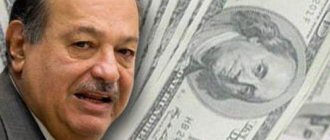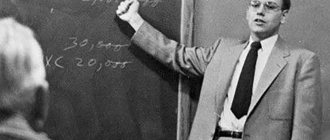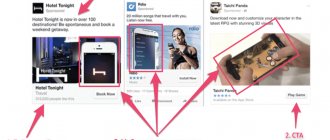Success story (biography) of Bill Gates.
Alfred Adler, a psychologist and psychiatrist from Austria who created a system of individual psychology, argued that successful people become so thanks to the constant desire for excellence. An example of his words was Bill Gates, who is today one of the richest people on the planet.
He is popular all over the world as the creator of the computer software industry.
USA Today describes Gates as someone who tries to compete at even the best party, not to mention a job where he is determined and ruthless.
The print publication Inc. calls Bill Gates "a restless bundle of energy." The success story of Bill Gates is like the embodiment of every American's dream. Through his hard work, he achieved not only the popularity of his company, but also the place of one of the richest people on the planet.
Today Bill Gates is the proud owner of $57 billion. Of course, Forbes magazine could not help but include him in the annual list of the richest people on earth, so in 2011 he was in second place with his $56 billion. Below you will find out exactly what Bill Gates' success story looks like. Biography of Bill Gates
Bill Gates' childhood and youth
Bill Gates was born in Seattle, Washington state. The young genius’s birthday fell on October 28, 1955, then, about sixty years ago, the path of this popular man began.
Bill's father is corporate lawyer William Gates, and his mother is FirstInterstateBank board member Mary Maxwell Gates.
The parents sent their son to study at the most prestigious school in Seattle, and then dreamed that he would continue his studies at Harvard Law School, repeating the path of Gates Sr. But young Bill was not interested in grammar, civics and other subjects that would help fulfill the wishes of his parents.
Already in high school, Gates devoted a lot of time to mathematics and wanted to become a professor in the future. In 1968, his passion for the exact sciences found its application. Then the management of the educational institution decided to purchase computer time based on the DEC PDP-10 microarchitecture system. Its owner was the General Electric company.
Bill Gates and his friend Paul Allen became seriously interested in the possibilities of computer technology. They even sacrificed schoolwork to learn as much information as possible.
Then Bill Gates was even able to write a simple simulation program with which you could play against the machine. The school authorities did not take their students seriously, and as a result, what should have been enough computer time for one year was wasted in a few weeks.
But the guys were lucky again, and a new student appeared in Lakeside, who gave them new opportunities. He was the son of the chief programmer at the Computer Center Corporation. The school entered into a new agreement, and Bill Gates and his friends were able to create their success story again.
The teenagers quickly realized what was what and, having studied all the intricacies of the machine, began to create trouble. They hacked the system, crashed it a couple of times, and replaced data on computer time spent. These pranks did not hide from the eyes of the SSS employees, after which the schoolchildren were suspended from computers for some time.
But weak protection and regular system failures greatly damaged the company’s business, after which they came up with the idea of using the extraordinary minds of teenagers. The SSS invited them to find flaws in the security system. For this, the children could use computer time as much as they wanted. Of course, they could not refuse such a lucrative offer.
Then the teenagers were completely under the power of machines. It didn’t matter to the comrades what time of day it was, since they were constantly in the laboratory. In addition to the activity on finding errors, teenagers were also interested in any information about automated calculations, so they developed their skills.
However, a year later the company fell on hard times again and eventually went bankrupt in 1970. Lakeside students were left without work or access to computer time. Since there was no way out, I had to look for new ways for self-realization. Here the guys were lucky again, because Paul Allen's father was a specialist from the University of Washington, which provided access to the computer center. Young programmers did not sit idle and were looking for a new job.
In 1971, Bill Gates' success story continued with InformationSciences, which hired guys to write payroll software. Here, in exchange for results, schoolchildren received not only computer time, but also money received from the successful operation of the software.
Bill Gates, while studying at school, was able to create another interesting program that created a class schedule. The genius included a loophole in its composition that allows you to choose classes with the most attractive girls. In high school, he not only learned the intricacies of computers, but also taught them to schoolchildren.
Young programmers were always provided with orders. As Gates himself later said, he was always the initiator, as he offered to call the real world and sell it something. Fortunately, his energy paid off because he found and sold. For example, he received $20,000 at age 15 for a program that optimized traffic.
Youth
Bill Gates was born on October 28, 1955 in Seattle. As I said, his father, William Henry Gates, was a successful lawyer, and his mother was a housewife. From a very early age, his parents were closely involved in Bill's upbringing and education. Already at school, his IQ was above average, he had an amazing, almost photographic, memory. While attending Lakeside School in his hometown, he picked things up on the fly. It was here that he first became acquainted with computers and at the age of thirteen, in the BASIC programming language, he wrote his first game - it was virtual Tic Tac Toe. When Bill entered eighth grade, he met his future business partner, Paul Allen. Together with Paul, Gates created various programs for his own purposes on the school computer. Later they even managed to start making money from it.
Bill and Paul
Over time, they gathered around them many guys who were interested, but understood little about computers. Many looked at Bill and Paul with temptation, because they did not experience any difficulties in handling complex computers; for them they were commonplace. Ultimately, the school formed a whole tech quartet, which included, of course, Bill Gates and Paul Allen, as well as Rick Wayland and Kent Evans. The four of them began frequenting the computer lab, where they could sit for hours at a high-performance PDP-10 computing station. A special program was installed on the computer, which limited the amount of possible time spent working at the computer. They devoted one of their days to hacking that very computer program in order to remove all restrictions, and, oddly enough, they succeeded.
PDP-10
This act did not go unnoticed and for the whole summer, four gifted students were forbidden to even come close to the computer. When the embargo lifted, the guys offered cooperation to Computer Center Corporation, which owned that same computer. Its essence was to search for vulnerabilities and flaws in software. Computer Center Corporation agreed to the proposal and until 1970, Gates and his friends studied the source codes of various software written in different programming languages - from machine code to FORTRAN. In 1971, one of the local companies hired a team of enthusiasts to work on a program for maintaining payment systems, but they were never able to finish work on it.
For reference, Gates previously wrote a special program for automatically creating a schedule, and rumors about this went far beyond the school. The program was so successful that the school decided to buy it from Gates for several thousand dollars. Therefore, while still a schoolboy, quite serious entrepreneurs began to turn to Bill for help.
Bill Gates' adult work
The parents were a little uncomfortable with their son’s success, so they asked him to stop working on computer projects. Bill Gates listened and spent a year without his favorite activity, during which time he began reading the biographies of great people from throughout history.
When the guy was approaching seventeen years old, he received an offer that said that Gates should write a software package for distributing the energy of the Bonneville Dam. His parents did not forbid him to take on this work, so he immediately began the project. A year of work on the task brought Gates 30 thousand dollars.
During their senior year, Gates and Allen got a new part-time job. TRW discovered a problem that the guys had already found in the ComputerCenterCorporation machine. But now they were asked to find ways to fix it. It is known that it was while working in this company that Bill Gates began to use programming skills.
This is where the idea of the next step in the success story was born, thanks to which they wanted to create a software company.
After graduating from school, Bill Gates became a student at Harvard University. It was planned to repeat the story to my father or go my own way and become a mathematics professor. But studying at the University did not interest him, since he was there only physically.
Gates spent little time directly studying, most often playing poker, bridge or pinball. There are many cases where geniuses, under the influence of circumstances, lost their skills and became ordinary people. Fortunately, this success story is not one of them. The desire for constant victories, the competitive spirit and dreams of great achievements never left Gates for a minute.
A school friend of the genius was suddenly offered a job in Boston. Together with Paul Allen, Bill Gates continued to work on programming. The guys learned that the MITS company was going to release the Altair 8800 personal computers. This happened in 1974, and the energetic Gates took the chance and offered the creator of this machine a programming language called BASIC. Here Bill had to lie a little, saying that this language was developed directly for the new computer.
But the success story continued just as happily, as the program immediately suited the company, and the guys received an offer to work on writing languages.
First acquaintance with a computer
Bill's math teacher, in which he excelled, described him as a student who "saw a shortcut."
Here Gates first became acquainted with a computer. He later recalled, “Getting to work with a computer in the late sixties was something for Seattle!” None of this would have happened if the School Mothers' Club had not raised money to buy a computer, a real miracle of technology at that time. It was not at all like modern thin laptops. A whole room was needed to accommodate it. And the calculation speed was several times lower than its modern analogues. Bill, along with his friend Paul Allen, who later became his business partner, sat with this “iron monster” days and nights. The fruits of this painstaking work were not long in coming.
Gates wrote his first program at the age of 13. It was a game of tic-tac-toe.
Then the parents showed a very reasonable approach to raising their gifted child. They did not create most favored nation treatment for him. Their main task was to encourage the ability to independently achieve their goals. After all, before giving a child something, you need to think about whether he really needs it.
Gates adopted the experience of his parents to raise his own children. According to the will he drew up, almost all the money he earned will be transferred to charitable foundations. The children will receive 10 million dollars (a very modest amount for such a rich person) and, most importantly, an excellent education.
Bill believes that children of any parents, even billionaires, should achieve everything themselves.
Gates has great respect for any work and encourages all young people to do the same. He says, “Frying burgers at McDonald's is not beneath you. Your great-grandfathers would have called any job, even this kind of job, a good chance.”
Nothing in life comes easy. Success and money must be earned and earned.
The love of work that his parents instilled in Bill from childhood greatly helped him achieve his goals. On this occasion, he once said: “A dollar can’t fly between an ass and a sofa.” Nothing to add here.
Already at the age of 15, Gates, together with Allen, created the first commercially successful project. It was a traffic control program. They earned $20,000. The Bonneville Dam power distribution program, developed when Bill was just 17, has already brought in $30,000.
Creation and development of Microsoft
In the same year, Bill Gates creates his own company, which begins to develop software. The computer genius calls it Microsoft , but in the original spelling the name looked different: Micro-Soft. Although the employees of the young company worked constantly, the beginning of its activities could not be called successful. Due to the lack of financial resources, difficulties arose in distributing the products. At first, the role of sales manager belonged to Bill Gates' mother.
Microsoft's first customers went bankrupt, but its employees did not lose heart. In 1979, the decision was made to go back to Seattle. By that time, Bill Gates had been expelled from the university because he practically did not attend classes. But this did not upset him at all, since soon IBM invited him to create an operating system for a personal computer, which was to become the very first in the world.
Unfortunately, the genius had to abandon this work, since he did not have the development to implement the project. At the same time, the creator of Microsoft advised the company to choose the services of a competitive company DigitalResearch. In the future, IBM will listen to Bill Gates' advice, and it will receive the development task.
A little about the billionaire's activities
It will be difficult to briefly tell the story of Gates' life and rise to a happy life, but we will try. The billionaire has many developments, projects and companies under his belt, including:
- Microsoft Corporation, which produces software for various types of technology, OS, equipment, games, applications and many interesting things (for example, Skype);
- The Corby Company, which reproduces paintings in various museums and galleries;
- Research Center;
- Two books that became bestsellers;
- A charitable foundation dedicated to improving medicine and reducing poverty;
- A toilet without water and sewerage, which can save a lot of money and solve waste recycling problems;
- The smart home where Gates lives with his family;
- Smart city built in Arizona;
- Dozens of environmental protection projects.
You need to understand that this is not all the work that Bill has done over the past decades. He has long become famous as a computer genius, philanthropist and speaker at international conferences.
Bill Gates does not sit still and continues his success story.
To gain time, Microsoft purchased the “raw” OS 86-DOS, spending 50 thousand dollars on this matter. In addition, the guys from the company that created this OS invite the direct developer of this project, Tim Patterson, to work with them. Bill Gates, together with Microsoft employees, worked to finalize 86-DOS, after which the operating system began to be called MS-DOS.
Having completed the work, Microsoft offers its IBM PC project. Thanks to the purchase of the “raw” development, Microsoft managed to get ahead of DigitalResearch. Subsequently, in the fall of 1980, IBM entered into an extensive contact with Bill Gates' company. It was he who radically influenced the history of personal computers.
Both IBM and Microsoft benefited from this activity. But it is difficult to say who benefited most from this. Bill Gates' company was able to bypass its competitor Digital Research, which in the future began to conduct business in a different direction. A detailed development of events can be seen in the biographical film “Pirates of Silicon Valley.”
Microsoft's development continued at a frantic pace, and already in 1981 it became a corporation managed by two people who had known each other since school: Bill Gates and Paul Allen. At the same time, IBM released its personal computer with MS-DOS 1.0. The software of this product also includes other Microsoft developments, for example, BASIC, COBOL, Pascal.
The company's rapid growth continues to be present. Microsoft is establishing a presence in the UK and Europe. In 1982, Bill Gates convinced the head of IBM that MS-DOS operating systems should be offered under license to other computer companies. He believed that in this way it would be possible to compete with Apple, which by that time was offering customers their own computers based on the operating system they had developed.
A few years later, Microsoft plans to release an OS based on a graphical interface, which was already used by its competitor company. At first, it was planned to test the graphical interface on our own Excel and Word programs, produced directly for Apple Macintosh machines.
1983 was the time for the development of a device called the Mouse manipulator, that is, a computer mouse. It was created to make entering information into machines with a graphical interface more comfortable. This year is also significant for the release of a new text editor for MS-DOS. Also, Bill Gates, together with his corporation, presents to everyone an extension of the MS-DOS operating system - Windows. It was announced as a multifunctional field in which many graphical applications could exist.
After 3 years, Microsoft enters the path of open sales. In one day, their price on the exchange increases from 22 to 28 dollars. In the spring of 1990, the corporation announced the accrual of dividends on shares. In addition, another share was a gift for shareholders.
Microsoft is the leader in its industry, as it owns 44 percent of the profits from the entire computer software market. That is why the enormous power of the corporation suppressed any desire for the development of competitors. One of them, Mitch Kapor, owner of Lotus, admitted in an interview in 1991 that the revolution was already over because Bill Gates won. He also added that today's software industry is like the kingdom of the dead.
The print edition of People personified Bill Gates as a true entrepreneur with innovative abilities. It explained that Gates was in his industry similar to Edison in producing the light bulb, an innovator, an entrepreneur, a salesman, and, undoubtedly, a genius.
Playboy magazine added to all the eulogies in 1991 that Microsoft saved the programming industry. It states that Bill Gates helped make the United States the epicenter of the software industry. In addition, that same year, Forbes magazine printed a photograph of the genius on the cover with the words: “Who can stop him?”
Already in 1993, the number of registered users of the company crossed the mark of 25 million users. This made Windows the most widely used GUI-based OS. At the same time, Microsoft Corporation produced Windows NT, which is positioned as a collection of operating systems for working servers and stations.
In 1995, the Windows 95 operating system was released. Sales of this product aroused such great interest among consumers that even people who did not own a computer purchased it for themselves. So, by the beginning of 1996, a huge number of copies of this operating system were distributed - 25 million.
The next two years were spent refining Windows NT, resulting in two versions of the software, 4.0 and 5.0.
In 1998, Windows 98 was released. Visually, it was similar to its predecessor, but had more improved features. A few years later, Windows 2000 appears, which becomes the best, according to customers.
Creation of Microsoft (Microsoft)
It was 1974. Bill Gates invited his friend to create a software company. Initially, the company was called a little differently - Micro-soft (with a hyphen). At first things didn't go well. It was difficult to find orders. In 1979, Bill was expelled from Harvard due to poor academic performance and truancy. Bill probably screwed up his studies. It must be assumed that Bill was not too worried about this, since in the same 1979 he received an order from IBM to create an operating system for one of the first personal computers.
An interesting move happened here. Initially, Bill refused IBM because... he did not have any groundwork, he suggested that IBM turn to another company (Digital Research). At the same time, Micro-soft buys the raw version of the 86-DOS operating system from just 50 thousand dollars. And they immediately invited the creator of this system, Tip Patterson, to work. The finished system was called MS DOS - and Bill introduced it for IBM computers. The contract was concluded in September 1980. And this was the beginning of the rise of Microsoft. In 1981, 16-bit MS DOS 1.0 was released for new IBM computers and included some software from Microsoft. Same Basic, Pascal.
The next step was to distribute MS-DOS under a license, and then create its own operating system with a graphical interface. Bill spotted these developments from Apple. Read more about the biography of Steve Jobs. But before creating an entire operating system in a graphical interface, it was decided to test the technology on Word and Excel programs, which were precisely developed for the Apple Macintosh.
In 1983, MS created the Mouse manipulator. At the same time, a text editor for MS DOS was released. At the same time, the appearance of Windows was announced - it was an extension, a graphical shell for MS DOS so that you could work with a graphical interface.
1986 - Microsoft held an initial public offering.
Subsequently, Microsoft began to occupy a monopoly position in the software market. People magazine compares Gates' contributions to the software industry to those of Edison. Bill has been called an innovative entrepreneur. In April 1991, Bill was on the cover of the respected business magazine Forbes and there was the inscription: “Can someone stop him?” As the Soviet Union collapsed, a revolution in the software market was taking place in the United States. And Microsoft set the tone for this new technological revolution.
1993 The number of MS Windows users is 25 million. In Russia, MS products were distributed illegally in the form of pirated copies for a long time. But many years later, we can say that this helped the company become a monopolist in the young market in Russia. Soon Windows NT was released - a version of Windows for workstations. Already in 1993, Windows became the most popular operating system with a graphical interface in the whole world.
1995 - Windows 95 was released, which caused a serious resonance in the market. By January 1996, 25 million copies of the new system had been sold.
1996-1997 - new versions of Windows NT were released - popular among programmers.
Later Windows 98, 2000, Millenium, XT, Vista, Windows 7 and others were released.
Bill Gates and his new achievements
In 2001, Microsoft released the Windows XP operating system, which people really liked, which is why it has not lost its popularity today. Over 5 years of sales of this system, more than 538 million copies were distributed.
In 2004, Bill Gates' success story led him to Warren Buffett, with whom they created Berkshire Hathaway. In other words, Bill Gates became an investor by investing in a company that combined funds for auto insurance, paints and textiles. Also, the creator of Microsoft bought a stake in the biotechnology company Bothell. The Gates Corporation has also become a kind of fund where the whole world invests money.
Six years after the release of Windows XP, the world saw the new Windows Vista operating system along with the new development of the Microsoft Office 2007 office suite.
On March 2, 2005, the British Foreign Office decided to award Bill Gates the title of Knight Commander of the Most Excellent Order of the British Empire for his serious efforts to help UK businesses and eliminate some of the world's poverty. This title is similar to a knighthood; its holder can only be a citizen of the United Kingdom, and it gives the holder the right to be called “sir”.
In the summer of 2007, 34 years after entering Harvard University, Bill Gates received his diploma. The most prestigious educational institution in the world decided to honor the genius with a document confirming higher education for special merits.
Success is very close
Steve Ballmer
Bill, despite his unique abilities, was not an excellent student. He had obvious problems with humanitarian subjects, but this did not stop him from passing the final exam at school with 1590 out of 1600 possible points. Thanks to this, Gates entered Harvard University without any problems, where he met another future companion, Stephen Anthony Ballmer. Ballmer served as CEO of Microsoft Corporation from 2000 to 2014 and currently has a net worth of $33 billion.
While Gates' peers went to parties and were into sports, the hero of our material was very far from this. He spent almost all his time studying multi-volume encyclopedias and writing programs on a computer. Bill's parents were so worried that they decided to seek help from a psychiatrist, because they were very frightened by their son's fanatical passion. He could not leave the computer for days at school. Gates Jr. was sixteen years old at the time.
The very first company that Bill founded with his comrades was Traf-O-Data. In it, they developed software and devices designed to record road traffic indicators. This project brought the guys their first big money - 20 thousand dollars.
The next step on the path to success for Microsoft was the conclusion of a cooperation agreement with the computer manufacturer Altair 8800. This happened completely by accident, Paul Allen just read a review of this computer in a magazine and he came up with the idea to offer Henry Roberts (the founder of the MITS company that produced Altair computers) their software development services for the device. When the two arrived at the company, they managed to convince Henry that having a BASIC interpreter on the computer would make it more attractive to consumers. Henry agreed to pay several tens of dollars from the sale of each computer to the young company. This was the first fateful scam in the life of the partners. They had neither an interpreter nor an Altair computer for which this interpreter was supposed to be intended, however, even here Gates found a way out of the awkward situation.
Altair was based on the Intel 8800 microprocessor and Gates had previously developed an emulator for it on a PDP-10 computer, so with the help of the Altair Programming Guide, Paul and Bill were able to optimize the interpreter for work with computers from MITS. The interpreter code was recorded on a special paper tape. The final moment was also not without incident. When it came time to send a working version of the interpreter to the customer, Paul remembered that he forgot to write a loader. During the flight on the plane, he was able to complete the missing element based on Intel 8080 machine code.
This was Bill Gates's first truly serious success. However, Microsoft (the former name Micro-Soft, derived from microcomputer software) at the beginning of its journey was not going through the easiest times. The company's office was located in one of the rooms of a cheap hotel. At first, the company held meetings with its clients there. The lack of finance was due to the mediocre sales of the company's products. They lacked a competent manager; at that time, his role was performed by Bill's mother. However, programmers did not despair and continued to work on improving the BASIC programming language. Ultimately, many companies became interested in purchasing a license to use the BASIC programming language. Even Apple was among them. In the future, the most important competitor.
Gates at the police station
It may seem that Gates devoted all his time to education and work, but this is not entirely true. In his youth, Gates loved and continues to love cars. But even more he loved the reckless and fast ride on them. One day, because of this, he was even arrested and prosecuted for speeding and ignoring road signs. This wasn't Gates' only legal trouble.
In the early 2000s, when the Internet was just beginning to develop, the incredibly convenient and therefore popular Netscape Navigator browser appeared on the market. It has been installed by millions of users around the world. Microsoft couldn't help but pay attention to a promising milestone that could bring in money. As a result, the company released perhaps the most hated browser in history - Internet Explorer, and the Netscape development team went bankrupt. US antitrust authorities paid attention to the technology corporation and began an investigation.
It turned out that Microsoft, which sold its Windows operating system to computer manufacturers, prohibited the installation of the Netscape browser on their products, threatening them with blacklisting. This led to lengthy legal proceedings lasting four years. Microsoft was taken under government control - this was tantamount to an admission of guilt by the company. Problems with the law did not benefit either Bill Gates or his company. The reputation was seriously tarnished. To rehabilitate himself, Bill Gates begins to engage in charity work and, together with his wife Melinda Gates, creates a family relief fund.
Let's go back a few decades. While Gates was still on his way to becoming the richest man on the planet.
Bill Gates leaves Microsoft
In January 2008, the Microsoft founder announced that he planned to leave the company in July of this year. This main event of CES 2008 took place at the opening of the ConsumerElectronicsShow. There, Bill Gates announced that he would manage the charitable foundation that he and his wife created in 2000. It is called the Bill & MelindaGatesFoundation, and its goal is to help projects in the fields of health and education. Finances from this fund are used to develop a vaccine to treat AIDS, as well as to help developing countries and their poor populations. In addition, a lot of money is spent on scientific and educational projects.
The opinion of Bill Gates' critics is that he actually spends much less money on philanthropy than other rich people. And some of the funds return back to Microsoft, as they are spent on purchasing computers with Windows and Office for educational institutions.
As promised, Bill Gates left Microsoft at the end of June 2008, handing over the leadership role to current CEO Steve Ballmer. In addition, the burden of responsibility on Ray Ozzie and Craig Mundy was increased. These are the people who run the company today.
But Bill Gates does not intend to leave the corporation completely, since he retains the position of Chairman of the Board of Directors, but without executive duties. Gates is also the largest owner of Microsoft shares.
Having left his first company, Bill Gates is founding a third one, which he gave the self-explanatory name BillGatesCompanyThree, which is translated as follows: the third company of Bill Gates. The new genius activity in bgC3 is presented as scientific research. This is a non-profit company that will not take on venture capital investments. According to regulatory documents, it will work to provide technological and scientific services, and bgC3 will also engage in research, analytics, and the development of new programs and hardware.
Although Bill Gates's success story at Microsoft is over, the corporation itself continues to evolve. The world can still enjoy the products of this company. For example, in the fall of 2009, a successor to Windows Vista, called Windows 7, was released, but compared to the previous version, the latter has better functional qualities. In March 2011, it was reported that it had sold over 300 million copies worldwide.
After Microsoft
In 2008, he left his position as head of Microsoft and focused his efforts on charitable activities. Heading his family charity foundation with his wife, he contributes money to overcome various major problems.
In his native Microsoft company, Gates owns 2.5%. At the same time, back in its heyday, the tycoon created a holding company whose main task was to search for profitable and stable investment projects. Cascade Investment was founded in 1994 and holds shares in 28 major global companies.
Bill Gates and his wife Melinda in Africa on foundation business
Litigation with Microsoft
always adhered to an ideology under which their competitors could not develop. She believed that power should belong only to her, but modern society did not agree with such business methods.
The success story of this corporation turned its head so much that they did not understand the fair rules of the game. The marketing policy was very tough, as Microsoft tried to grab a tastier piece. In mid-1990, it crushed browser maker Netscape's attempt to gain popularity. Microsoft believed that everyone in the world should only use their Internet Explorer browser, which was included in the next version of the software.
Here, representatives of the US antitrust authorities could no longer remain silent, so in 1998 charges were brought against Microsoft. It said that company representatives were behaving dishonestly with consumers and competitors. By that time, Bill Gates had already left the post of CEO of the corporation and became the head of the board of directors, and also took a position that he invented himself - “chief software architect.” As a result, he was summoned before a judge named Thomas Penfield Jackson for questioning. The conversation lasted about 17 hours.
Witnesses to the interrogation reported that Bill Gates behaved unpleasantly - he avoided questions or answered unkindly. He was tirelessly boring and tried to be cunning, trying to pay attention to meaningless little things. For example, he became sincerely interested in the meaning of the terms “ask”, “compete”, “we”. To questions that he did not want to answer, Bill Gates said that he did not remember anything, and this began to happen so often that even the judge began to grin. But, according to the testimony of prosecutorial specialists, all those details that he tried to conceal (as a rule, this concerned intimidation of competitors and waging an unfair fight) could be confirmed, since they were in the accused’s email.
Thanks to the correspondence, it was found out that the creator of Microsoft promised Netscape to “strangle” and “extinguish” its activities. But during the interrogation he did not dare repeat his words. The trial lasted 4 years. As a result, his corporation was forced to pay fines, penalties, and they were also made to promise to conduct business in a more civilized way. But, in fact, little has changed in the company’s ideology after this incident, which is why lawsuits are still arising.
Bill Gates character
An important personality trait of Bill Gates is the ability to see someone else's talent and intelligence. He always said that he didn't hire fools. This is what made his success story. Sometimes Gates himself conducts an interview with an applicant for an open position. If necessary, he is able to call and persuade a valuable employee. Although Bill Gates has little free time, he always finds it to maintain intellectual capital. The main weapon against competitors is the strongest and smartest programmers. This is the main wealth of Microsoft. We can say that Bill Gates is the first person who became a capitalist of intellectual abilities.
The desire to get ahead of everyone, to do better than others, haunted Bill Gates from a young age. It was a huge success - dominating the computer technology market. The vast majority of people on our planet have Microsoft software installed on their computers. What more could you ask for?
But Bill Gates is not inspired by his own success story, and he prefers never to relax.
All-consuming pragmatism and endless work are what characterize Bill Gates well. To work always and everywhere is what a genius strives for. In his opinion, rest is a sign of weakness. He tries to work many hours every day, because he believes that if you do nothing, then everything you have achieved will no longer have meaning. Here he is right, since in the world of computers everything happens very quickly.
Marriage and the birth of children
At the age of 39, Bill Gates decides to tie the knot with one of the Microsoft employees, Melinda French. Subsequently, the couple created a joint charitable foundation and became the parents of three children - daughters Jennifer Katharine (1996), Phoebe Adele (2002) and son Rory John (1999).
6. Wedding, 1994.
Bill Gates and 11 rules of success
Bill Gates has always been and remains a frequent guest at various educational institutions, where he tells his story of success and conveys his own vision of problems to students. The end of every visit is the same - the billionaire talks about 11 things that are not taught anywhere. Bill Gates says that education in the style of political correctness has led to the fact that children are not adapted to the real world and cannot exist in it.
1. Get used to the fact that life is unfair. 2. Society is not interested in your level of self-esteem, since it only expects achievements from you. 3. After completing your training, you will not immediately earn large sums of money and occupy the post of vice president. You need to work hard at first. 4. You may have decided that I am very strict with you, but these are flowers. Soon you will have a boss. 5. Is it low to make hamburgers? Your ancestors thought differently, as this was the only option to get back on your feet. 6. If you can’t do something, then it’s not your parents who are to blame, but you yourself. There is no need to suffer, you need to learn from mistakes. 7. Parents' behavior was not always so boring. Maybe the desire to do everything for you influenced them? They provide you with everything and listen that you are the best. Before you criticize the previous generation, start working on yourself. 8. There are probably no losers at school, since it is almost impossible to stay a second year. You are given many attempts which will eventually lead to you moving on to the next class. Everything in life is different. 9. In the real world there are no semesters, no vacations, and your employer will not determine your purpose with you. You will have to look for yourself in your free time from work. 10. There is no real life on screens. In reality, you can't spend the whole day sitting in a cafe with friends. 11. Treat nerds more gently, as one of them may become your boss in the future.
Family and hobbies of a billionaire
Bill Gates is not only a successful person, but also an excellent husband and father. In 1994, he tied the knot with Melinda French, who became Melinda Gates after her marriage. Two years later, they had their first daughter, Jennifer, three years later, their son Rory, and in 2002, their daughter Phoebe. The first meeting of Bill and Melinda took place in 1987 during a corporate press briefing. It turned out that the future wife of the billionaire had already worked at Microsoft for many years.
After the wedding, Melinda left her place of work. Today the Gateses live in a luxurious house near Bill’s hometown of Seattle. Land and property taxes on this luxurious building alone amount to approximately $1 million annually.
There is a huge amount of electronics in the house. There is a building occupying 40 thousand square meters. pounds, near Lake Washington. The Gates' home is valued at $40 million. The so-called house of the future consists of three pavilions connected to each other. The materials for their construction were glass and pine wood.
On a hill there is a garage with a capacity of three dozen cars. It also houses the museum's Mustang, which once belonged to the young Gates. One pavilion is designed for entertaining guests. The reception area offers wonderful views of the Olympic Mountains. The entire wall of the room is occupied by a huge screen, which includes 30 monitors. Each guest at Bill Gates' house is given an electronic pin on which the visitor's preferences are encoded.
In the central pavilion there is a library, for which the owner purchased several works of art. The ceiling of the hall is a huge dome with wooden inlays. Near this pavilion there is a trampoline where Gates could perform his thoughts. Also in the luxurious house there was room for a swimming pool, which smoothly flows into a Japanese bath. Melinda and Gates love to relax there.
Not far from the building there is a trout lake. During the construction of the house, Bill Gates wanted to give preference to a simple style, but after the wedding, Melinda influenced his decision, so the house acquired some elegance.
Bill Gates, like any programmer, loves fast and dashing driving. At first he was the owner of a Porsche 911, due to the frenzied driving of which the billionaire was kept in custody, from where Paul Allen rescued him. Afterwards, Bill acquired other cars, for example, Jaguar Hove, Ferrari 348. Gates never wore a seat belt while driving.
In addition, the billionaire's favorite pastime is reading, as well as playing bridge and golf.
Microsoft Software for IBM PCs
As the computer industry grew, with companies such as Apple, Intel and IBM developing hardware and components, Bill was constantly on the road to promote the merits of Microsoft software applications. He often took his mother with him. Mary was highly respected and well connected through her membership on several corporate boards, including IBM. It was through Mary that Bill Gates met the CEO of IBM.
In November 1980, IBM was looking for software that would run on their new personal computer (PC) and turned to Microsoft. Legend has it that during his first meeting with Bill Gates, someone from IBM mistook him for an office assistant and asked for coffee.
Gates looked very young, but he quickly impressed IBM, convincing them that he and his company could meet their needs. The only problem was that Microsoft had not developed a core operating system that would run on the new IBM computers.
Not to be deterred, Gates bought an operating system that was designed to run on computers similar to IBM PCs. He made a deal with the software developer, making Microsoft the exclusive licensing agent and then the full owner of the software, but did not tell them about the deal with IBM.
The company later sued Microsoft and Gates for hiding important information. Microsoft settled the matter in court for an undisclosed amount, but neither Gates nor Microsoft admitted any wrongdoing.
Gates had to adapt the newly acquired software to run on IBM PCs. He delivered it for a fee of $50,000, the same price he paid for the software in its original form. IBM wanted to buy the source code that would give them the information for the operating system.
Gates refused, asking IBM to pay a license fee for copies of the software sold with their computers. This allowed Microsoft to license the software, which they called MS-DOS, to any other PC manufacturer if other computer companies cloned the IBM PC, which they soon did. Microsoft also released software called Softcard, which allowed Microsoft BASIC to run on Apple II computers.
By 1983, Microsoft had entered the global market with offices in the UK and Japan. Approximately 30 percent of the world's computers ran his software. Bill Gates's rivalry with Steve Jobs
While their rivalry is legendary, Microsoft and Apple shared many of their early innovations. In 1981, Apple, then led by Steve Jobs, invited Microsoft to help develop software for Macintosh computers. Some developers were involved in both Microsoft development and the development of Microsoft applications for the Macintosh. Collaboration can be seen in some common names between Microsoft and Macintosh systems.
It was through this exchange of knowledge that Microsoft developed Windows, a system that used the mouse to control the graphical interface and display text and images on the screen. This was very different from the text and keyboard based MS-DOS system, where all text formatting was displayed on the screen as code rather than what was actually typed.
Bill Gates quickly realized the threat that this type of software could pose to MS-DOS and Microsoft as a whole. For the unsophisticated user—which was the bulk of the buying public—the graphical representations of VisiCorp's competing software used on the Macintosh system would have been much easier to use.
In an advertising campaign, Gates announced the development of a new Microsoft operating system that would use a graphical interface. It was to be called "Windows" and would be compatible with all PC software developed under MS-DOS. The announcement was a bluff, as Microsoft did not have such a program in development.
As a marketing tactic, this was pure genius. Almost 30 percent of the computer market uses the MS-DOS system and will wait for Windows software rather than upgrade to a new system. Without people willing to change formats, software developers were reluctant to write programs for the VisiCorp system, and by early 1985 it had fallen into disuse.
In November 1985, almost two years after its announcement, Bill Gates and Microsoft launched Windows. Visually, the Windows system looked very similar to the Macintosh system that Apple Computer Corporation had introduced almost two years earlier.
Apple previously gave Microsoft full access to their technology while it worked to make Microsoft products compatible with Apple computers. Gates advised Apple to license its software, but they ignored this advice as they were more interested in selling computers.
Once again, Gates took full advantage of the situation and created a software format that was strikingly similar to the Macintosh. Apple threatened to sue, and Microsoft responded by saying it would delay delivery of its Microsoft-compatible software to Macintosh users.
In the end, Microsoft prevailed in the courts. This can prove that although the functioning of the two software systems was similar, each individual function was completely different.
Outside the company, Bill Gates developed a reputation as a ruthless competitor. Several technology companies, led by IBM, began developing their own operating system called OS/2 to replace MS-DOS. Instead of bowing to pressure, Gates moved forward with Windows software, improving its performance and expanding its use.
In 1989, Microsoft introduced Microsoft Office, which combined office applications such as Microsoft Word and Excel into one system compatible with all Microsoft products.
Applications were not as easily compatible with OS/2. Microsoft's new version for Windows sold 100,000 copies in just two weeks, and OS/2 soon disappeared. This left Microsoft with a virtual monopoly on PC operating systems. Soon, the Federal Trade Commission began investigating Microsoft for unfair marketing practices.
During the 1990s, Microsoft faced a number of investigations by the Federal Trade Commission and the Department of Justice. Some related allegations are that Microsoft entered into unfair agreements with computer manufacturers who installed the Windows operating system on their computers. Other allegations were that Microsoft forced computer manufacturers to sell Microsoft Internet Explorer as a condition of selling the Windows operating system with their computers.
At some point, Microsoft faced the possible collapse of two of its divisions - operating systems and software development. Microsoft defended itself by harking back to Bill Gates' previous battles with software piracy and saying such restrictions were a threat to innovation. Ultimately, Microsoft was able to find an agreement with the federal government to avoid collapse.
Despite all this, Gates found inventive ways to deflect the pressure through light-hearted commercials and public appearances at computer expos, during which he impersonated Mister Spock from Star Trek. Gates continued to run the company and withstand federal investigations throughout the 1990s.
In 1987, a 23-year-old Microsoft product manager named Melinda French caught the attention of then 32-year-old Bill Gates. Very bright and organized, Melinda was a perfect fit for Gates. Over time, their relationship grew as they discovered a close and intellectual connection. On January 1, 1994, Melinda and Bill got married in Hawaii.
After the devastating death of his mother from breast cancer just months after their wedding in 1995, Bill and Melinda Gates took their time off to travel and gain a new perspective on life and the world. In 1996, their first daughter, Jennifer, was born. Their son Rory was born in 1999, and their second daughter Phoebe arrived in 2002.
Bill Gates - writer
Bill Gates is also a writer. In 1995, he published his own book, “The Road to the Future,” which contains his views on the life of society with the development of information technology. Journalist Peter Rynarson and Microsoft Vice President Nathan Myhrvold became co-authors of the publication. For the first couple of months, the book ranked first among NewYorkTimes bestsellers. The publication was undertaken by the American publishing house Viking. "The Road to the Future" has spread to more than 20 countries. The book remained on the bestseller list for 18 weeks.
When she refocused her activities on Internet technologies, Gates republished the book, making her own adjustments to it. In the second version of the book, the writer pointed out that the emergence of interactive networks is one of the most important developments in the history of mankind. This book was published in paperback in 1996 and became a bestseller.
Bill Gates' third book was published in 1999, and it was called "Business at the Speed of Thought." In it, the author explained how information technology can influence the solution of business problems. Bill Gates' co-author in this case was Collins Hemingway. The book is sold in more than 60 countries. It was highly acclaimed by critics and was included in the bestseller lists of many print and non-print publications. Since the book was released in 25 languages, Bill Gates' work became known even in places where he had not been heard of before.
Much has also been written about Bill Gates himself. We know of more than a hundred publications that have been recognized as reference books on the biography of a given person. The billionaire did not escape the fate of many famous people, so meticulous journalists invented new facts from his biography. But the genius was of little interest in the activities of such people, as he stubbornly continued to achieve his goals. The most published book of the last century concerns Bill Gates and is called “Janet Law. Bill Gates speaking." It describes the personality of a genius as vibrant and world-changing.
In this publication, the talent of the billionaire was considered to be almost devilish escapades, and in the man himself the beginning of the destruction of the world.
Recently a film was made about Bill Gates - “Bill Gates: How an Eccentric Changed the World.” It talks about the childhood, youth and success story of a billionaire. There is another film that mentions Bill Gates, but it talks about everyone who is in any way connected with the development of IT technologies, for example, Paul Allen, Steve Jobs and others . It is called "Pirates of Silicon Valley". No matter what direction one talks about Gates, one cannot help but admit that the world needs him more than he needs him in the world.
Way to Wealth
The tycoon's life path began in Seattle. Here, on October 28, 1955, a boy was born into the family of a successful lawyer, William Henry Gates II, and the daughter of a major banker, Mary Maxwell Gates, whom the happy parents named Bill.
Bill Gates with his sisters
School
At first, the baby studied in a regular school. From an early age he was distinguished by a good memory, an inquisitive mind, and a love of mathematics.
In 1968, the parents transferred the bright child to Lakeside, a private school. At the same time, the school opens a computer center with sponsorship money from parents.
The boy began to disappear from the school programming club. Computers take up all his time. At the age of 13, the future computer tycoon created his first program, and the very next year he earned some money from his programming efforts. Here he meets high school student Paul Allen, a future partner in the creation of Microsoft. Friends even founded a company in which they managed to earn $20,000 by writing programs.
Gates and Allen in the computer lab
Bill graduated from school with excellent grades in mathematics.
Harvard
In 1973, the young man easily entered the best national university - Harvard.
But doubts about the correctness of his choice do not leave him even within the walls of an elite institution. He skipped classes and spent too much time at the computer. The guy couldn’t decide what he wanted to do in life, what he should do next.
Bill Gates spent a lot of time at the computer in his youth
However, in higher mathematics he received only excellent marks in exams.
Microsoft is born
Life changed dramatically when his friend Allen, returning from Gates one January day, saw a magazine about popular electronics on the counter. The title of the publication featured a photograph of the new Altair-8080 MITS computer. Paul, purchase in hand, rushed back to Bill. Both understood that they couldn’t miss the chance, otherwise the dream of creating a home computer on everyone’s desk would be realized by someone else. Gates no longer had the problem of what to do next in life.
The young men immediately contacted the head of MITS and assured him: they had what he needed - the BASIC programming language suitable for this computer. In response, he informed them: the company receives a lot of similar proposals, so the contract will be received by the one who writes and delivers the finished program faster.
The young people began working at a frantic pace, secretly using the university's main computer, which was reserved only for student projects. We had to model the customer’s car using a book that described the computer; a mistake could have led to the failure of the idea. Two months later, Gates’ talent did its job, and the program was ready.
Allen demonstrated it to the customer. The program immediately started working, and MITS offered further cooperation.
Bill creates Micro-Soft with Paul. Its employees were former classmates of friends. Soon the hyphen in the company name disappeared and in the fall of 1976 a new company, Microsoft, was registered. Under pressure from Gates, the shares were distributed as follows: Allen got 36%, Gates - 64%.
Deal of the century
The next milestone in the history of how Bill Gates achieved success is the deal between Microsoft and the largest computer monster, IBM Corporation. Gates managed to sign a contract with IBM in 1980 to create software. This is how the MS-DOS operating system was developed and delivered to the customer.
A lucrative contract overnight turned MS-DOS into a standard and launched Gates’s meteoric rise as the youngest billionaire.
In June 1981, Microsoft became a corporation, and Gates became its leader.
The result of further fulfillment of the contract with IBM was the Microsoft Windows OS, which appeared in the fall of 1985. This event marked the beginning of the era of Windows - the operating system that brought fame and huge money to Bill Gates.
In the spring of next year, Microsoft shares began to be traded on the stock exchange. In one day of trading, Gates earned $61 million.
A few months later, his total wealth reached a billion dollars.
In January 1992, the value of Microsoft's shares at auction increased to $114 per share. Bill Gates became the richest man in the United States for the first time.
The company's next major product, the Windows 95 OS, was sold in 2 weeks with 7 million copies. At that time, 80% of personal computers were running Windows 95.
At the Windows 95 presentation
On May 28, 1997, Gates sells 340 thousand shares of Microsoft and earns $39,142,500.
Today, Microsoft Corporation is still the largest manufacturer of software for a variety of technology.
From 1996 to 2020, with the exception of 2008, Gates regularly ranked first in the ranking of the richest people in the world according to Forbes.
The network calculates how much Bill Gates earns (in dollars):
- per month – 1 billion.
- per day – 32.3 million.
- per hour – 1.3 million.
- per minute – 22,400
- per second - 373.
What is the current state of the founder of IT technologies in rubles? If recalculated at today's exchange rate, this will amount to 5069.364 billion rubles.
In an effort to share with people his thoughts on the future of new technologies, Bill Gates wrote two books: The Road to the Future (1995) and Business at the Speed of Thought (1999). The latter is recognized as a bestseller.











